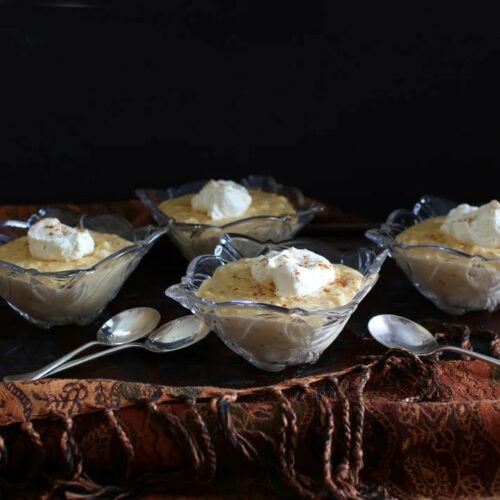As you’ll figure out from my blog, I’m pretty attached to old-fashioned puddings and treats – particularly those I grew up with. Sago pudding, with its comforting sweet custardy texture and delicious gelatinous sago pearls was always a favourite in our family. We kids used to call sago ‘fish eyes’ – hardly an appealing description, but we loved it regardless.
Mum’s had her recipe for sago pudding for donkey’s years – has no idea where she got it from but, as chance would have it, I found virtually the same recipe on Bite.co.nz. What I love about this version is that it has a caramel flavour thanks to the addition of brown sugar. It’s also very creamy in texture, due to the higher proportion of milk to sago – I’m really not a fan of claggy sago-heavy puddings.
I pretty much stuck to the original recipe, though added vanilla for extra flavour, reduced the sugar a wee bit, and scaled up the ingredient portions to ensure there was enough for five dyed-in-the-wool pudding eaters (our motto: If you’re gonna ‘do’ pudding, do it properly). I also added some cream in with the milk for an even creamier version, which seemed to go down very well.
This particular version separates out the egg whites from the yolks, making for a lighter, frothy pudding. However, I’m just as sold on the quicker alternative of adding the whole eggs in, which makes for a denser, creamier outcome. The recipe below includes both alternatives, so try them both out and decide which you prefer.
It may be old-fashioned, and you might even call it ‘simple’, but this sago pudding is satisfying to its core for kids of all ages! Enjoy!


CARAMEL SAGO PUDDING
Ingredients
- 1/2 cup unpacked brown sugar
- 3 tbsp unsalted butter
- 1/4 tsp salt
- 30.4 fl oz whole milk (I used 20.2 fl oz milk and 10.1 fl oz cream)
- 3 tbsp sago pearls
- 3 large eggs
- 1 tsp pure vanilla extract
Instructions
- Place the brown sugar, butter and salt in a large saucepan (you want the mixture to only half fill the pan) over moderately high heat until it melts and combines. Boil for one minute.
- Carefully stir in milk and sago (don’t worry if the caramel seizes and hardens – it will melt again as the mixture heats back up).
- Turn down the heat to low and cook at a gentle simmer (stirring constantly so that the sago doesn’t catch and burn at the bottom) until the sago pearls become translucent – they can still have tiny pin points of white at their centre. This will take 25-30 minutes. Occasionally scoop up the sago pearls with a dessert spoon to check for doneness. If any sago pearls clump together, you can easily separate them by gently poking the clump with a spatula or spoon.
- When the sago is translucent and the mixture has thickened, take off heat.
Continue with either version 1 or 2 below:
- VERSION 1: Separate eggs. Whisk egg yolks until frothy and add a little of the hot sago mixture into the yolks in a fine stream, while whisking, to temper the eggs (i.e. ensure they don’t cook). Then pour the tempered egg mixture back into the saucepan with the sago mixture and whisk to combine. Place pan back on the heat for one further minute, whisking constantly, but don’t let it boil or the eggs will curdle. Take off the heat, place the pan in a water bath, whisking for another minute, and then stir in the vanilla extract. Whisk the egg whites until they are firm, but the peaks fall (i.e. not stiff). Using a metal spoon, fold the egg whites into the sago mixture.
- VERSION 2: Whisk whole eggs until frothy and add a little of the hot sago mixture into the eggs in a fine stream, while whisking, to temper the eggs (i.e. ensure they don’t cook). Then pour the tempered egg mixture back into the saucepan with the sago mixture and whisk to combine. Place pan back on the heat for one further minute, but don’t let it boil or the eggs will curdle. Take off the heat, place the pan in a water bath, whisking for another minute, and then stir in the vanilla extract.
To continue for both versions:
- Let the mixture cool a little (whisking from time to time to avoid a skin forming on top) before spooning into individual dishes. The pudding can be eaten warm, at room temperature or chilled from the fridge.
- Serve with dollops of softly whipped cream and a sprinkling of cinnamon.









